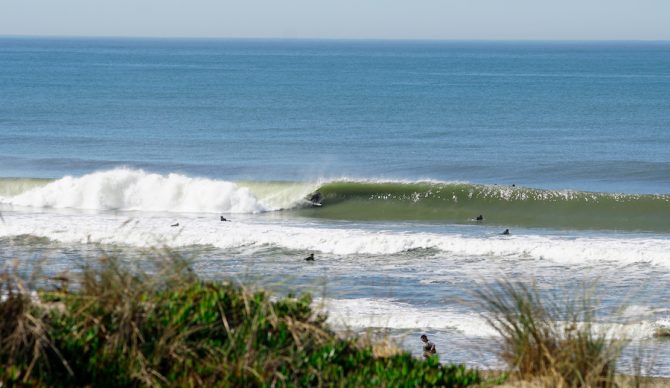
Fall days at Ocean Beach, San Francisco. Photo: Solomon Fragakis
A gigantic seawall is set to reshape San Francisco’s Ocean Beach. After the Coastal Commission gave the project a green light last week, local surfers continued to voice their concerns about what could become of the famous sand-spitting tubes the beach is known to produce.
Long story short, the city thinks its plan to armor the coast with a seawall and sand replenishment will solve the erosion problem. Surfrider disagrees, saying the wall will exacerbate erosion, and a retreat of coastal infrastructure coupled with restoration of dune habitat is preferable.
For those unfamiliar with the unique dynamics of Ocean Beach, the controversy can sound rather abstract. After all, the north end of the beach already has a seawall; what makes this project different? To unpack the issue, I spoke with Bill McLaughlin, a longtime Ocean Beach surfer who was formerly Surfrider Foundation’s lead on its “Restore Sloat” campaign.
McLaughlin broke down how this proposed seawall could profoundly alter Ocean Beach.
For those who don’t intimately know Ocean Beach, can you explain what this particular part of the beach is like as far as the waves and cliffs?
The south of Sloat area is a stretch of shoreline that, first of all, is our go-to area for double overhead surf. It’s much easier to paddle out and get outside compared to the rest of the beach. It’s got good deep-water channels, generally speaking, for people to get out. So it’s really important, in that sense. It also happens to be the first place that waves were ridden in San Francisco. So it’s got that historical aspect. But the problem is that the shoreline down there has always been really narrow because of the way the road comes out toward the water. There’s a bend in the road and that’s really what’s causing all the trouble. The city put a sewer tunnel under that bend in the road, right under the curve. So it basically juts right out into the shorebreak and the seawall will do the same.
Can you explain why exactly you think the seawall will have adverse effects?
Because of where the shoreline position is now, during the upper half of the tide, most of that seawall will be built essentially in the shorebreak. It’s going to be quite a thing to watch them push the ocean back to pour concrete and lay the wall. But when they’re done, the idea is to use sand replenishment to create a beach. We already know that the tide line wants to be at the wall and we expect the sand replenishment to wash away very quickly, as it already has in prior sand replenishment projects.
For someone who points at the north end of Ocean Beach, which has a seawall and a wide beach, can you explain why that couldn’t be replicated on the south end?
There’s been an ongoing sand accretion trend at the north end of the beach that started in the 1990s, whereas at the south end, there’s been steady, incremental erosion. The seawall at the north end is not a problem because of that trend – the beach is getting wider. It has something to do with the sand transport and hydrology. The U.S. Geological Survey is trying to figure out what’s going on. They don’t know why, but they do recognize that it’s occurring.
How did it play out the previous times they replenished the sand at Sloat?
There have been various sand replenishment projects. Most of them have been fairly modest, but basically, they last till the next big swell, and then half the sand is gone. The significant one was done by the Army Corps of Engineers in 2021 during the pandemic. It was an East Coast-style sand replenishment where they pumped sand from a dredge ship offshore and created a massive sand dune in front of this curve in the road. That dune and beach were around 50 to 70 feet from the edge of the road. It looked like a dune. It completely covered all the riprap and looked like what we really wanted. But within three months, I’d say more than half of it washed away. By the end of the next year, the only thing that was left of it was the sand on top of the riprap.
Do you know when the seawall construction is slated to start?
2025 or 2026. I forget exactly. But not long.
Are the Ocean Beach surfers organizing to resist? What’s the next step forward?
We’re going to have to really lay the wood on the decision makers of the city – everybody that’s done this. This will pretty much destroy a section of beach and make it extremely unsafe to access the water, to come in and out from surfing, particularly in the upper half of the tide. As years progress and sea level rise takes hold, I would expect that the shoreline will even be underwater at low tide. So this is a real problem. We’re going to have to get involved if we’re going to have any chance to save Ocean Beach, restore that area, and put everything on a better path going forward. This approach to sea level rise is extremely disruptive to beaches and we’ve got to be a voice to say there is an alternative path.

